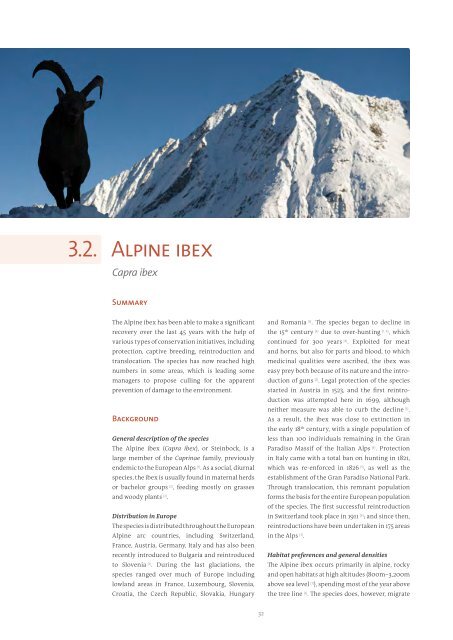130925-studie-wildlife-comeback-in-europe
You also want an ePaper? Increase the reach of your titles
YUMPU automatically turns print PDFs into web optimized ePapers that Google loves.
3.2. Alp<strong>in</strong>e ibex<br />
Capra ibex<br />
Summary<br />
The Alp<strong>in</strong>e ibex has been able to make a significant<br />
recovery over the last 45 years with the help of<br />
various types of conservation <strong>in</strong>itiatives, <strong>in</strong>clud<strong>in</strong>g<br />
protection, captive breed<strong>in</strong>g, re<strong>in</strong>troduction and<br />
translocation. The species has now reached high<br />
numbers <strong>in</strong> some areas, which is lead<strong>in</strong>g some<br />
managers to propose cull<strong>in</strong>g for the apparent<br />
prevention of damage to the environment.<br />
Background<br />
General description of the species<br />
The Alp<strong>in</strong>e ibex (Capra ibex), or Ste<strong>in</strong>bock, is a<br />
large member of the Capr<strong>in</strong>ae family, previously<br />
endemic to the European Alps [1] . As a social, diurnal<br />
species, the ibex is usually found <strong>in</strong> maternal herds<br />
or bachelor groups [2] , feed<strong>in</strong>g mostly on grasses<br />
and woody plants [2] .<br />
Distribution <strong>in</strong> Europe<br />
The species is distributed throughout the European<br />
Alp<strong>in</strong>e arc countries, <strong>in</strong>clud<strong>in</strong>g Switzerland,<br />
France, Austria, Germany, Italy and has also been<br />
recently <strong>in</strong>troduced to Bulgaria and re<strong>in</strong>troduced<br />
to Slovenia [2] . Dur<strong>in</strong>g the last glaciations, the<br />
species ranged over much of Europe <strong>in</strong>clud<strong>in</strong>g<br />
lowland areas <strong>in</strong> France, Luxembourg, Slovenia,<br />
Croatia, the Czech Republic, Slovakia, Hungary<br />
and Romania [3] . The species began to decl<strong>in</strong>e <strong>in</strong><br />
the 15 th century [4] due to over-hunt<strong>in</strong>g [1, 4] , which<br />
cont<strong>in</strong>ued for 300 years [4] . Exploited for meat<br />
and horns, but also for parts and blood, to which<br />
medic<strong>in</strong>al qualities were ascribed, the ibex was<br />
easy prey both because of its nature and the <strong>in</strong>troduction<br />
of guns [5] . Legal protection of the species<br />
started <strong>in</strong> Austria <strong>in</strong> 1523, and the first re<strong>in</strong>troduction<br />
was attempted here <strong>in</strong> 1699, although<br />
neither measure was able to curb the decl<strong>in</strong>e [5] .<br />
As a result, the ibex was close to ext<strong>in</strong>ction <strong>in</strong><br />
the early 18 th century, with a s<strong>in</strong>gle population of<br />
less than 100 <strong>in</strong>dividuals rema<strong>in</strong><strong>in</strong>g <strong>in</strong> the Gran<br />
Paradiso Massif of the Italian Alps [4] . Protection<br />
<strong>in</strong> Italy came with a total ban on hunt<strong>in</strong>g <strong>in</strong> 1821,<br />
which was re-enforced <strong>in</strong> 1826 [5] , as well as the<br />
establishment of the Gran Paradiso National Park.<br />
Through translocation, this remnant population<br />
forms the basis for the entire European population<br />
of the species. The first successful re<strong>in</strong>troduction<br />
<strong>in</strong> Switzerland took place <strong>in</strong> 1911 [6] ; and s<strong>in</strong>ce then,<br />
re<strong>in</strong>troductions have been undertaken <strong>in</strong> 175 areas<br />
<strong>in</strong> the Alps [3] .<br />
Habitat preferences and general densities<br />
The Alp<strong>in</strong>e ibex occurs primarily <strong>in</strong> alp<strong>in</strong>e, rocky<br />
and open habitats at high altitudes (800m–3,200m<br />
above sea level [7] ), spend<strong>in</strong>g most of the year above<br />
the tree l<strong>in</strong>e [2] . The species does, however, migrate<br />
32


